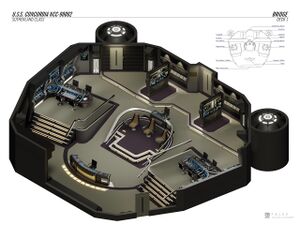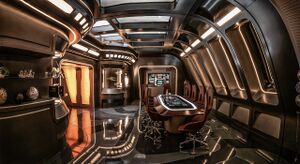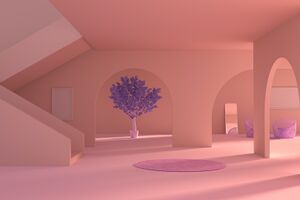USS Sarek
More actions
"What greater source of peace exists than our ability to love our enemy?"
Ambassador Sarek quoted for the USS Sarek's dedication plaque
The USS Sarek (NCC-91806) was a Sutherland-class heavy cruiser assigned to the Fourth Fleet in Task Force 17. After an extensive shakedown cruise to calibrate her cutting-edge scientific technology, the Sarek was launched under the command of Captain Taes in 2400. Like a city in space with its crew of nine hundred, the USS Sarek operated as a mobile research platform in every scientific specialty. This Sutherland-class starship’s mission module was configured for the social sciences — specializing in mission of archaeology and anthropology. As a lightly-armed vessel whose tactical systems were primarily defensive in nature, the USS Sarek specialised in second-contact missions, conducting comprehensive study and analysis of the discoveries found by Task Force 17's deep space operations.
Design and Layout
Main Bridge
Located on deck one, the main bridge served as the USS Sarek’s command centre, from where the captain supervised starship operations and gave the most critical orders about the ship’s flight control, tactical decisions, and scientific exploration. The interior design of the Sutherland-class bridge module emphasised collaboration by grouping sets of workstations into hubs, rather than postings around the circumference of the bridge. Like many ships of the line in 2400, the design aesthetic featured bulkhead and deck plating in metallic of burnished bronze, transparent “glass”, and reflective copper, along with deep maroon upholstery and tawny faux-leather.

Located at the heart of the bridge was the captain’s chair —on a raised platform that was wrapped by a horseshoe-shaped arch— and two companion chairs for the executive officer, second officer, mission specialist or counselor. The tactical station had a seated console directly behind the captain’s chair and the CONN panel was located ahead of the command platform in a sunken flight control well.
To the port and starboard of the command platform were raised hubs of LCARS workstations for science officers and engineering/operations officers, respectively. Each hub consists of an elongated U-shaped conference table —inset with LCARS panels— to allow for pairs of officers to work facing one another, along with further LCARS interface panels set into the bulkheads. Two further freestanding, double-sided LCARS interface panels --the size of master system displays-- were positioned at the aft of the bridge for configurable mission ops parameters. These panels were stationed at an angle perpendicular to the viewscreen. The viewscreen itself was a holographic overlay to the style of wide transparent viewports that had come back into fashion in bridge design.
Observation Lounge

Located in the aft of deck one, the observation lounge aboard the Sarek was one of the standard modular designs from ships of the line in 2400. The observation lounge was intended as a space for the senior staff and other officers to collaborate, celebrate, and make plans for the journey ahead. Continuing the architectural design from the bridge and the passageway, every surface of the bulkhead and decks were plated in metallics of burnished bronze and reflective copper, with practical lighting set into the overhead. The overhead and outer bulkhead visibly curved in kind with the shape of the outer hull, with tall rectangular viewports allowing a view of the stars and the Sarek’s mission pod.
Large double doors at the aft of the bridge allowed access to the observation lounge, with additional doors on the port and starboard side of the lounge providing access to the captain’s ready room, a head, and further deck one. The starboard side doorways were tucked into an alcove adorned with a widescreen LCARS panel for private consultation away from the observation lounge at large.
Stationed parallel to the bridge doorway, in the heart of the room, was a natural-edge wooden conference table of a roughly rectangular shape. Set into the surface of the table were both holographic projectors —for displaying images and data on the surface of the table or on holographic LCARS panes projected at respective eye-levels— along with induction warming plates to keep platters of food warm. The table was circled by ten office chairs, of a shape inspired by a retro-throwback to the 2360s, and upholstered in a deep maroon textile which was commonly used in the bridge as well.
Opposite to the viewport, build-in shelves and a replicator were set into the bulkhead. The story of Captain Taes’ command —across the USS Nestus, USS Dvorak and USS Sarek— was being told by the objet d’art on the shelves. These items included a couple of modern Romulan sculptures to welcome the Sarek’s team of scientists from the Romulan Free State, a broken widget from the refineries on Kunhri III, a small model of an archaeological recreation of a Camus II temple might look like, a framed isolinear chip, and three stone carvings —in the Vulcan style— of the Starfleet starships named Sarek: an Excelsior-class starship, an Ambassador-class starship, and a Sutherland-class starship.
Captain's Ready Room
Located in section sixteen of deck two, the captain’s ready room was accessible from the corridor, as well as from a stair-access doorway, off of the observation lounge on deck one. The purpose of the captain's private compartment was for reflection, meditation and philosophical debate. Given all of the other work areas available aboard a Sutherland-class starship, Captain Taes did not permit transactional duties, such as performance reviews or delivery of orders in this space. Rather, the ready room was a retreat from the clamorous activity of the main bridge to ponder the scientific mysteries of the universe, to invent new methods of inspiring a crew of nine-hundred, or deepening one’s understanding of thine own self.

The minimalist design of the compartment was intentionally surreal —including the lack of any viewports, the intense bubble-bum pink colour-scheme from overhead to deck, and the inclusion of stairs leading down from deck one— to create a separation from average starship life. Stepping into the ready room was mean to feel as if one was walking into a pocket dimension. The ready room was partitioned into several smaller areas to allow for walking around, or kinhin, with several open archways to cause the “doorway effect” of releasing mental blocks and resetting the memory.
Instead of traditional furniture or replicators, mats were positioned around the ready room for sitting or other floor postures. Otherwise, the space was designed for standing and pacing. Aside from LCARS panels disguised as framed art, the space was decorated in a minimalist fashion. A freestanding mirror was available for literal reflection and a potted pink and purple tree took the point of pride in a sub-compartment to prompt paradoxical meditation by presenting the natural and the artificial in the same object. Only in the most internal compartment of the ready room labyrinth were there two wireframe, beanbag-like chairs for seating two people. These were located behind a doorway to silently communicate to guests that they were not welcome to join the captain’s meditation unless she expressly invited them to participate in intellectual, ethical or emotional debate.
Operational History
At launch in late 2400, the USS Sarek's mandate was for external scientific exploration and research, along with internal diplomacy. A team of seventy-five civilian scientists from the Romulan Free State were permanently assigned to the Sarek with a Romulan liaison officer serving as Chief Science Officer. The intention of this great experiment was to explore improved diplomatic relations between the Federation and the Free State. Although their missions assigned from Starfleet were of great import, the real mission was for both crews to learn to work as one. This mission was expected to take months if not years, through small, daily interactions --both of great import and tedious minutia-- to accomplish the joint-effort of exploration and scientific research.
